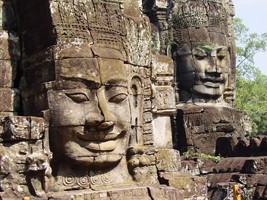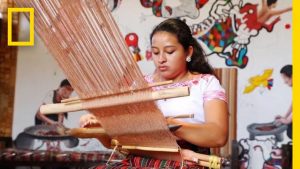Cultural Heritage is a phrase which explains the ways of living developed by a community and passed on from generation to generation. It includes customs, practices, places, objects, artistic expressions and values. Cultural Heritage is both intangible and tangible in nature. Culture is a complex term; it has different meanings. It is a way of life that is vital for the survival of a specific group or people living in a specific society. It includes the way they dress, the way they behave, the way they talk, the type of music they hear, the food they eat, so on.
Tangible and intangible elements of Cultural Heritage: Cultural heritage is the legacy of physical artifacts and intangible attributes of a group or society that are inherited from past generations, maintained in the present and presented for the benefit of future generations. Cultural heritage includes tangible objects such as buildings, monuments, landscapes, books, tools, works of art, and artifacts. It also includes intangible features such as traditions, oral folklore, music, performing arts, social practices, rituals, festive events, knowledge and practices concerning nature and the universe or the knowledge and skills to produce traditional crafts. It also includes culturally significant landscape, biodiversity, important trees and shrubs, important rivers and this heritage requires active effort on our part in order to safeguard it. They are significant due to their present or possible economic value, but also because they create a certain emotion within us, or because they create a sense of belonging within us. Our identity includes country, state, village, our religion, our society, our culture.
Angkor Wat: One of the most important archaeological sites in South-East Asia, Angkor Archaeological Park in Cambodia contains the glorious remains of the various capitals of the Khmer Empire which was officially the Angkor Empire – the predecessor state to modern Cambodia, was a Hindu-Buddhist empire in Southeast Asia. Over the years, political and military upheavals, illicit excavation, pillaging of archaeological sites and landmines were destroying the site. Many monuments still need systematic curing. Do you know that Angkor is one of the famous tourist destinations and there is a growing pressure from the tourists to conserve the magnificent archeology? More than fifteen major conservation and restoration projects have been undertaken. In 2004, a committee set up by UNESCO checked the safety work done; the committee considered that Angkor was being properly managed and that the numerous conservation and restoration activities were successful and the site was removed from the List of World Heritage in Danger. Angkor is a sprawling heritage site spread over 400 square kilometer.
Culture and its heritage reflect and shape values, beliefs, and aspirations, thereby defining a people’s national identity. It is important to preserve our cultural heritage, because it keeps our integrity as a people.
Weaving of Guatemalan Women: This country is in Central America in South Mexico. Its culture is a fusion between Spanish and Maya cultures, however the indigenous population has many traditions that have remained a part of their culture since the time before the Spanish came to what is now Guatemala. The various Maya communities in Guatemala have their own cultural identities, from language to identifying patterns in their textiles. Blackstrap weaving and the textiles that Maya women create are intricate parts of indigenous communities. Each community has a distinctive pattern they create when weaving and are proud to wear. Due to social and political discrimination, Maya languages and art forms are becoming vulnerable.
The threat to Maya culture in Guatemala comes from a variety of social and political issues. There is a great deal of discrimination and marginalization against the indigenous population. This has led to high levels of poverty and resulted in many young people from rural villages migrating into the cities in order to pursue perceived financial opportunities. One of the factors associated with youth urban migration is the lack of cultural appreciation and understanding of their culture as important to preserve. In schools, students are encouraged to learn Spanish and shown that opportunity lies in jobs associated with urban centers. There are not many job opportunities in rural areas and high levels of poverty, further motivating young people to seek opportunities elsewhere. Due to a lack of appreciating their own culture and the desire to find better economic opportunities, many young people are not learning the traditions of their culture.
For women weavers specifically, there are various social influences that affect weaving and the ability of women to weave. Some of these include education, specifically education that does not promote culture and encourages women to stop weaving and seek employment elsewhere, economics, which has made weaving more of an entrepreneurial feat than a solely cultural one. Intercommunication between communities and the demands associated with fashion, tourism, imagery, and transformation become drivers of change in weaving culture. Young women want to get an education, wear the clothes they see on TV and find jobs that provide more money than weaving can. They are not being shown how weaving is a skill they should be proud of, that people from around the world find interesting and valuable.
Why preserve weaving? The practice of weaving and creating the unique textiles which are very highly valued around the world will be lost without a concerted effort to show young people it is something worth valuing. Weaving is not only an indigenous Maya practice that has been around for thousands of years, it is also a living art form. Weavers are not only designers, but are skilled artists and artisans creating beautiful pieces that tell stories. Weaving patterns, designs, and colors are as numerous as the villages around Guatemala, each one bringing to life a special and unique history of the village it originates from. To lose this art form and knowledge would be to break apart the connective tissue of the Maya community. If culture and heritage are both irreplaceable sources of life and inspiration, if culture is a basic need that makes a community thrive, then it is fundamental to preserve this defining piece of Maya culture in Guatemala.
The importance of preserving biodiversity: Cultural heritage and natural history of a nation has a very high value and is unique. It is an identity that can be introduced to the world. Culture and its heritage reflect and shape values, beliefs, and aspirations, thereby defining a people’s national identity. For example natural resources are part of cultural heritage.
Picture of Bamboo Farming in Mendha village in Gadchiroli
Mendha in Gadchiroli: One such example is that of natural resource conservation at the village of Mendha in Gadhchiroli district of Maharashtra. In 1987, the villagers renewed their efforts at biodiversity conservation. It was decided that no commercial exploitation of the forests, except for Non-Timber Forest Produce, would be allowed. Further, villagers would themselves regulate the amount of resources they could extract from the forests and undertake measures to tackle soil erosion. Forests would not be set on fire. Encroachment would not be allowed. The important aspect of this community is that the villagers decide for themselves, yet they are open to information from the outside world.
The Chipko movement: also called Chipko Andolan dates back to 1739 AD which started to save trees or conservation of forests in India where people prevent trees from being cut down. It started in Kartikey Kamboj village of Rajasthan in which 363 Bishnois sacrificed their lives to save Khejri trees. Again in 1970 in Reni village of Chamoli district, Uttarakhand people went on rallying to prevent deforestation, to expose vested interests, increase ecological awareness, and demonstrate the viability of people power. Above all, it stirred up the existing civil society in India, which began to address the issues of tribal and marginalized people.















































